|
DIVA at Škuc Gallery
A study exhibition of DIVA Station, a physical and web archive of video art
28 May-20 June 2009
Opening event: Thursday, 28 May at 19.00
Škuc Gallery, Stari trg 21, Ljubljana
Concept of the exhibition: Zemira Alajbegović, Barbara Borčić, Miha Colner, Dušan Dovč, Ida Hiršenfelder, Neven Korda
Curator: Barbara Borčić
Producer: SCCA-Ljubljana
Co-producer: Škuc Gallery
You are kindly invited to attend a talk, presentation and discussion accompanying the opening of the exhibition in Škuc Gallery on Thursday, 28 May, at 19.00, followed by a viewing of material from DIVA Station digital video archive at 21.00.
A study exhibition entitled DIVA at Škuc Gallery showcases the DIVA Station archive of SCCA-Ljubljana, presenting it as a 'live archive'. It includes an educational programme, practical demonstrations, theoretical contributions, representative video works, curatorial selections and international collaboration, and also presents theoretical, practical and artistic aspects of audio-visual archives of contemporary art.
DIVA Station is a physical and web archive of video art which has been developing since 2005, and is one of SCCA projects, which seek to research, document and archive video/media art: Videodokument, Videospotting, Internet Portfolio, Artservis Collection and e-archive. DIVA Station is a partner in the GAMA (Gateway to Archives of Media Art) international internet platform, which brings together European video/media archives to make them more visible and easily accessible.
The exhibition gives an insight into various archiving processes, the development of video equipment and changes in the use of technological tools. Video works and curated video programmes from DIVA Station can be seen at screenings and in a viewing room, where every visitor can view their own selection. To make their choice easier, we have prepared several sections which present the DIVA Station in all its thematic and structural diversity, including overviews of individual artists, music videos, Škuc-Forum video production, Videospotting (curated selections), video and television, SCCA exhibition projects, and international video.
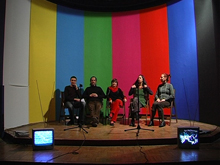 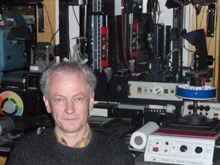
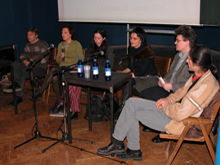 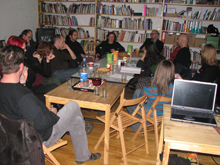
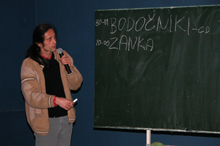 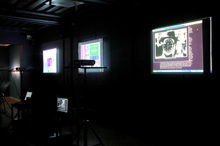
OPENING EVENT: LECTURE, PRESENTATION, DISCUSSION
Škuc Gallery, Stari trg 21, Ljubljana
Thursday, 28 May at 19.00
- Andreas Spiegl: Geography of the Media
The lecture will focus on the increasing availability of information and its implicit translation into codes of compatibility offering new maps of contexts and references. This process of de-contextualisation and re-contextualisation is based on a translation of works and contents into identifiable fragments that can be linked and connected in order to install a new geography of relations beyond any historical or territorial backgrounds. In the realm of this geography of media one finds most of all information about something one has not been looking for. The modes of research are turned into modes of discoveries. That is why the question for archives and mainly for media archives will be the production of identifiable contexts beyond the fragmentation of information into data - a question of mapping discoveries.
 Andreas Spiegl studied art history at the University in Vienna. He is lecturer on media theories at the Institute for Cultural Studies and vice rector of the Academy of Fine Arts Vienna. He is freelance curator and critic and published numerous texts on contemporary art and media theories and urbanism. Andreas Spiegl studied art history at the University in Vienna. He is lecturer on media theories at the Institute for Cultural Studies and vice rector of the Academy of Fine Arts Vienna. He is freelance curator and critic and published numerous texts on contemporary art and media theories and urbanism.
- Presentation of DIVA Station and the GAMA international platform
 |
ACCOMPANYING PROGRAMME
Škuc Gallery, Stari trg 21, Ljubljana
Project Room SCCA, Metelkova 6, Ljubljana
- Monday, 1 June at 20.00
Seducing the Gaze, presentation of documentary series of TV Slovenia, educational programme (2009) on contemporary Slovenian art: Vadim Fiškin, Sašo Sedlaček, Damijan Kracina, Marko A. Kovačič, Marija Mojca Pungerčar, Polona Tratnik, Uršula Berlot, Son:Da, script, direction, editing: Amir Muratović
Below, we will present the role of the video archive and the problems that the archive establishes when connecting to the contemporary technological and computer tools; but first let us take a look at what the object of a video archive actually is. At DIVA Station (Digital Video Archive) the answer seems simple. We focus on collecting video material in three categories: art video, video documentation of art events, and video documentation of theoretical discussions and other sources which refer to contemporary art and provide a context for the examination of (in our case) video works. Still, this does not answer the question of what the object of a video archive is.
First, let us address the contradiction between digitation and the notion of an archive, as an archive is primarily supposed to store originals and not 'copies'; however, this is not possible with numerous media carriers, as there are very few devices remaining which can read them, and only the most experienced experts know how to operate them. Moreover - which is the most worrying factor - the devices are becoming unusable or even defunct. Since their emergence in the 1960s, there have been many technical improvements of the carriers and recording standards, often not due to the quest for higher quality, but because of market logic. In the last forty years, there have been over 30 formats, the most well-known including U-matic, BetaSP, Video8, VHS, DVD and MiniDV. The composition of the carrier, reliability and stability of their parts vary greatly - but, contrary to the general belief, the magnetic tapes should not disintegrate sooner than in thirty years if stored correctly. Unreliability has reached a critical point with digital carriers like the DVD, which is not only unstable, but due to compression, provides relatively low quality of information. Because the carriers are unstable, we are faced with a contradiction that the information can only be preserved by copying. So the core object of a video archive is the art content, not so much the original 'master' in its physical form as an object. Some archives, which have on their disposal the appropriate air-conditioned spaces and sufficient funding, are able to also focus on storing master copies, but unfortunately, this is not the case with SCCA - Ljubljana.
Our video archive is based on facsimiles - precise copies of the highest possible quality of video works. In this regard, we should therefore first consider what does the process of digitation actually mean. Digital archiving does not mean that information is copied and compressed in DVD format or kept on a hard disk. These two methods are only supportive side effects which serve to satisfy the need for an archive to be available to the professional and wider public. The primary purpose of an archive is the storage of an artistic content as an important segment of tangible and intangible mobile heritage and historic memory. Considering the technology that is available to us, facsimiles of a video works can be stored in the most reliable way on MiniDV, DigiBeta and D5 format. We have opted for the most accessible - MiniDV, which requires a recording on hard disk in DV PAL codec. By following these guidelines, we are able to partly overcome the contradiction between the notion of the archive and digitation, as we ensure that the digitised version is a true facsimile of a video work.
The collecting of material for DIVA Station is based on a documentary, archival and research project on video art in Slovenia Videodokument: Video Art in Slovenia 1969-1998, which was developed at SCCA-Ljubljana between 1994 and 1999, and was followed by numerous curatorial selections of the gathered material, introduced under the common title of Videospotting. There were also research and exhibition projects: What Is Going on Concerning Audiovisual Archives? (2005) and in What Is to Be Done with Audiovisual Archives? (2007) and numerous consultations and talks with artists, curators and other experts and international collaborators who are directly confronted with the issue of storing video art and establishing video archives.
DIVA Station is based on collecting video documentation within a wider national context, and includes artists who work in Slovenia and/or abroad. Here, it needs to be noted that any attempt to build an overall archive is based on the criteria of discrimination and interpretation, which are the result of criticality, that inevitable leads to the incompleteness of the archives. Archives significantly contribute to historical cultural consciousness; however, they are in all respects conditioned by ideological assumptions and laws of (affirmative) discrimination. They fail to present historical events or objects in their entirety, but are based on 'cultural' relations, which can be clearly identified through an analysis. Despite this incompleteness and the need for continuous upgrading and improvement of the archives, the procedures for the treatment of the materials need to be clearly defined by a typology of terminology, which creates a cartography of conceptual frameworks within which a video art work (in our case), or some other audio-visual material is discussed. This system provides quite straightforward tools for mitigating the contradictions which are inevitable when the system of an archive encounters various artistic approaches. This typology for discussing video materials has been defined in collaboration with the partners of the GAMA platform by classifying vocabulary entries into three categories: art work, events and sources. The art work category is divided into different types: art video, documentary video, art film, experimental video, one-minute video, music video, video installation, interactive art, television art, fiction, animation, video performance, dance video, travel video, computer graphics, sound and hybrid art. These entries should include all areas of media art production. In discussing an individual art video, it should be taken into consideration that art works often include more than one type. The category of events is divided into workshops, discussions, festivals, concerts, performances (footage of performances which were not specifically edited or created by an artist, even though they feature an art work), lectures, presentations, exhibitions, screenings and seminars. Documents, articles, catalogues, interviews, essays and books are classified as sources.
In addition to detailed description of the art work with the data about author, the production year, the producer, the setting, the co-workers (music, editing, programming, camera...) and the technical description of any possible damage or other characteristics of the primary material, special attention is drawn to the style of writing a short synopsis of an art video. The synopsis on the Internet interface of DIVA Station forms an index of words which enable a more precise search for art works and connects them according to the content. Therefore, the hierarchy of description in the synopsis is set first and foremost by the visual art parameters and media characteristics, while the description of the narration of the work is adjusted to the demands of a particular work or the artist. The entry is also linked to other internet sites that would already feature a certain art work.
For a short time, at the beginnings of video art and its subsequent admittance to the television media carried with it the very optimistic prospect that the accessibility of video would enable complete democracy of the media. These idealistic expectations had not been realised, but they did foretell the emergence of a new media - the Internet, where the illusion of democracy is almost convincing. This brings us back to the notion of 'accessibility', which has sparked passionate debates and a sort of 'archive fever' about the preservation of media art in the last decade. The issue of accessibility and knowledge dissemination (in this case, knowledge about video art in Slovenia) is questionable not only due to technical demands; it is problematic also from the perspective of copyright. Here we do not refer to copyright law, but the artist's right to be acquainted with and to have influence on the context, interpretation and ways of presentation of their work. Therefore, the task of the archival institution is not only the systematisation of the documentation in databases, and preservation of art works and knowledge dissemination. It also needs to establish effective communication channels between artists and other creators of audio-visual archives and audiences. Presenting the video art archives on the web portal does not enable complete control, which at first seems like a drawback. At the SCCA, Centre for Contemporary Arts - Ljubljana we are convinced that this tool will open up video art interpretation, since registration on the portal allows artists and professional audiences (after editorial review) to add texts and web links, which will increase the knowledge about video art and it's context.
Ida Hiršenfelder
 |
Concept of the exhibition: Zemira Alajbegović, Barbara Borčić, Miha Colner, Dušan Dovč, Ida Hiršenfelder, Neven Korda
Curator: Barbara Borčić
Exhibition design and set-up: Damijan Kracina
Web archive programming: Borut Savski
Web archive design: Ajdin Bašić
Collaborators of DIVA station and the exhibition: Igor Grom, Damijan Kracina, Janez Krmelj, Zdene Kuzmič, Miha Vipotnik (advisers); Luka Dekleva, Neven Korda, Luka Prinčič, Borut Savski, Andrej Intihar, Boštjan Čadež, Art Group RGB (workshop); Vuk Ćosić, Peter Tomaž Dobrila, Ana Nuša Dragan, Heike Helfert, Martin Horvat, Jasna Hribernik, Rene Rusjan, Duba Sambolec, Sašo Sedlaček, Saša Šavel, Igor Španjol, Apolonija Šušteršič, Melita Zajc, Samo Zorc, Gaby Wijers (discussions participants); Boris Garb, Ana Grobler, Mateja Rot, Hana S. Vodeb (project group); Sara Femec, Nika Gričar, Michel Mochor, Špela Škulj (volunteers); Metod Novak (programming support)
Producer: SCCA, Center for Contemporary Arts - Ljubljana
Co-producer: Škuc Gallery
Gallery program is funded by Ministry of Culture of RS and City of Ljubljana.
Acknowledgment: Alenka Gregorič, Tevž Logar, Joško Pajer, Atila Boštjančič (Škuc Gallery staff), Kinodvor, MGLC Ljubljana, GAMA and partners' archives, Marko A. Kovačič, City of women
|

